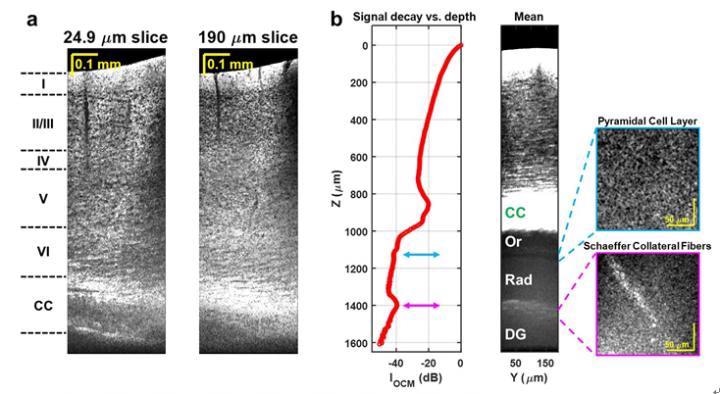Diseases in the central nervous system (CNS), like Alzheimer’s disease (AD), show up early at the microscopic, or cellular, level deep within the brain.
 (a) Minimum intensity projection sagittal images, or “slices”, with different projection thicknesses in the coronal direction, show cortical cytoarchitecture and the corpus callosum (CC), without physical tissue slicing. (b) OCM signal decay (left panel) and averaged coronal image (middle panel) show sub-cortical layers. CC: corpus callosum; Or: stratum oriens; Rad: stratum radiatum; DG: dentate gyrus. Image Credit: Jun Zhu, Hercules Rezende Freitas, Izumi Maezawa, Lee-way Jin, and Vivek J. Srinivasan.
(a) Minimum intensity projection sagittal images, or “slices”, with different projection thicknesses in the coronal direction, show cortical cytoarchitecture and the corpus callosum (CC), without physical tissue slicing. (b) OCM signal decay (left panel) and averaged coronal image (middle panel) show sub-cortical layers. CC: corpus callosum; Or: stratum oriens; Rad: stratum radiatum; DG: dentate gyrus. Image Credit: Jun Zhu, Hercules Rezende Freitas, Izumi Maezawa, Lee-way Jin, and Vivek J. Srinivasan.
However, the optical microscopes that are used to view cells present in the living brain are invasive or superficial. While whole-brain imaging methods like magnetic resonance imaging are deep and non-invasive but do not offer a cellular resolution.
A research group headed by Professor Vivek J. Srinivasan from the Departments of Ophthalmology and Radiology and Tech4Health Institute, NYU Langone Health, USA, and their collaborators have jointly developed a label-free optical microscopy method that exhibits an exclusive potential to image deep, with high resolution and least invasiveness.
The study was published in the journal Light: Science & Applications.
The researchers mainly demonstrated an in vivo high numerical aperture optical coherence microscopy (OCM) method that makes use of the 1700-nm water absorption window, where attenuation of light by scattering and absorption has been reduced.
The water absorption window measuring around 1700 nm, also called the third near-infrared (NIR) window, features a local water absorption minimum and comparatively low scattering. In OCM, a wider spectrum offers a finer axial resolution, as well as a robust potential to block scattered light that results in blurring of the image. Yet, the complete 1700-nm window, spanning from 1560 to 1820 nm, is mostly not utilized.
“The transition from standard wavelengths to 1700 nm OCM, while optimally using the entire water absorption window (not just a portion of the window), has been very difficult to date due to the numerous optical engineering challenges,” the researchers explained.
Such difficulties include severe chromatic dispersion, noisy detectors and light sources and a lack of standardized optical components. The researchers tackled such problems by selecting a low noise supercontinuum light source, a tailored numerical dispersion compensation method and an optical system design.
Such technical advances enable the imaging of neuronal cell and myelin architecture throughout the full depth of the mouse neocortex, and a few sub-cortical regions, via a thinned-skull preparation that maintains the intracranial space.
“The results represent unprecedented depths for cellular-scale brain imaging through a minimally invasive preparation. We next investigated the 5xFAD mouse model of Alzheimer’s disease (AD), which is expected to show a gradation of pathology with cortical depth. The imaging results confirmed the appearance of severe pathology in deep but not superficial cortex, which would be missed by more superficial imaging techniques.”
One more essential feature of the technique is that the image contrast emerges from the inherent properties of the brain itself. OCM does not need transgenic mice or administration of compounds. Plaques, neuronal cell body loss, demyelination of axons and local tissue modifications can all be imaged.
The scientists predicted, “Now disease can be visualized deep in the mouse brain with a simple surgical preparation, without exogenous labeling. The 1700 nm optical window can also quantify tissue water and lipid content in vivo, which may provide further insights into disease progression.”
Journal Reference:
Zhu, J., et al. (2021) 1700 nm optical coherence microscopy enables minimally invasive, label-free, in vivo optical biopsy deep in the mouse brain. Light: Science & Applications. doi.org/10.1038/s41377-021-00586-7.